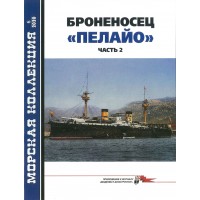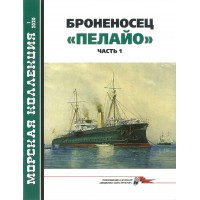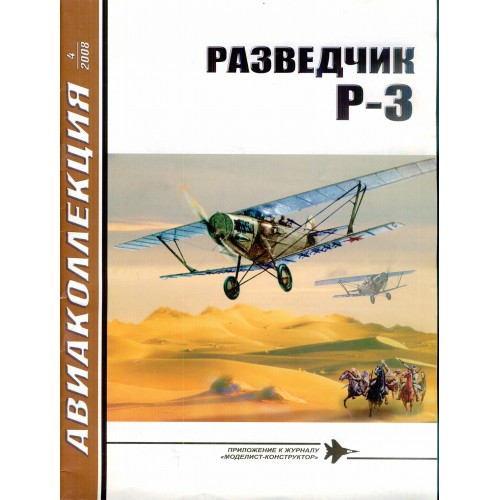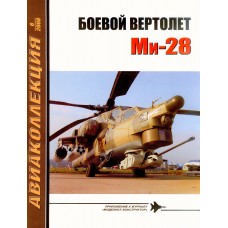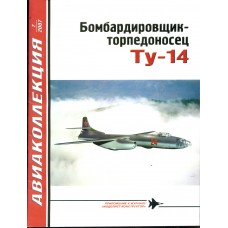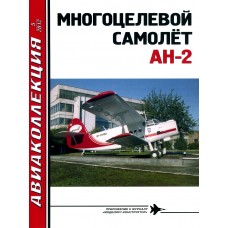AKL-200804 AviaCollection / AviaKollektsia 04/2008: Tupolev R-3 Reconnaissance Aircraft. Photos, schemes, colour pictures. 32 pages, soft cover, text in Russian.
CREATING A PLANE
The first combat aircraft designed under the leadership of A.N. Tupolev in AGOS TsAGI, became a reconnaissance version of the passenger ANT-2, but it remained on paper, not being embodied in metal. It was into metal, since Tupolev was exclusively engaged in metal aircraft construction, using an alloy of chain-aluminum created at the Kolchugino plant, which was a domestic analogue of German duralumin.
The experience gained while working on the ANT-2 was successfully used in the next project, ANT-3 (future R-3). At the beginning of 1924, NTK UVVS issued TsAGI with a task to build a two-seat all-metal reconnaissance aircraft for an American inline V-shaped water-cooled engine Ford Liberty with a capacity of 400 hp. In July, work began on the draft design of the machine, and on September 15, UVVS and TsAGI entered into an agreement that determined the date of readiness of the first prototype - March 18, 1925. According to the instructions, the scout was supposed to have a maximum speed of 215 km / h and a ceiling of 5500 m with a payload of 820 kg ... Like all aircraft of a similar purpose at that time, it could be used to support troops on the battlefield, for which it carried bomb and machine-gun weapons.
The chief designer of the aircraft was A.N. Tupolev. The design of individual units was supervised by A.I. Putilov (fuselage), V.M. Petlyakov (wing), N.I. Petrov and E.I. Pogossky (motorcycle installation). For the scout, they chose a one-and-a-half-plane scheme. The upper wing stood above the fuselage on two very short boars. The fuselage itself had a cross-section close to triangular.As conceived by the designers, this automatically increased the stiffness of the frames (a triangle, unlike, say, a parallelogram, is a rigid figure) and made it possible to facilitate the power set of the fuselage. This was important because the thin (0.3 - 0.6 mm) chain-link corrugated sheathing was not load-bearing. The chassis was made somewhat unusual. As a rule, at that time the wheels were mounted on one common axle. At ANT-3, they designed pyramidal-type struts; the curved part of the inner strut was a semi-axle for the wheel. The shock absorbers were made not of plate, but of cords - rolled rubber bands were located in the boxes, which worked not in compression, but in tension. The motor was cooled using cylindrical Lamblin radiators with rotating inlet flaps, new for Soviet aircraft construction. The scout was armed with one Vickers synchronous machine gun mod. 1924, located outside on the left side, and coaxial machine guns "Lewis" mod.1924 mounted on a Tur-4 turret in the rear cockpit. Eight bomb racks for small bombs and a mechanical bomb release were provided. The scout's equipment also included a hand-held perspective Potte 1bis camera.
Due to a lack of materials and insufficient development of the technology of metal aircraft construction, the construction of a prototype machine was delayed. The date of delivery was postponed to May 15, 1925, and the assembly was practically completed only by July 10. After the elimination of minor problems in August, ANT-3 was transferred to factory tests. They were conducted by V.N. Filippov. The aircraft was tested with two types of propellers: the TsAGI type and the British one from the DH.9 reconnaissance aircraft (with the latter the results were better). During the tests, Filippov flew Moscow - Kharkov. It turned out to be no easy task - we wandered in the rain and fog for almost 2.5 hours. In total, during factory tests, the ANT-3 flew about 30 hours and on October 26 was transferred to the Air Force Scientific Experimental Airfield (NOA) for state tests.
They did not start immediately. The military put up a long list of shortcomings that they demanded to be eliminated before starting flights. The improvements were completed only by December 30, when they made their first flight. Unfortunately, the radiators were leaking from vibration. This delayed the continuation of tests until the end of January 1926.
On January 29, R-3 was again ready to take to the sky. State tests ran from February to April. The new reconnaissance aircraft was flown by a crew of pilot M.M. Gromov and Letnaba B.S. Vakhmistrov. The plane was not yet fully equipped, only a turret was used for armament. "Liberty" rotated a two-blade wooden TsAGI propeller with a diameter of 2.87 m.
AKL-200804 AviaKollektsia N4 2008: Tupolev R-3 Reconnaissance Aircraft magazine
- Brand: AviaCollection / AviaKollektsia
- Product Code: AKL-200804 In Stock
-
$3.90
Available Options
Look at these products too:
AKL-200806 AviaKollektsia N6 2008: Mil Mi-28 Russian Attack Helicopter magazine
AKL-200806 AviaCollection / AviaKollektsia 06/2008: Mil Mi-28 Russian Attack Helicopter. Photos, sch..
$3.90
AKL-201205 AviaKollektsia N5 2012: Antonov An-2 Colt Soviet Utility Aircraft magazine
AKL-201205 AviaCollection / AviaKollektsia series 05/2012: Antonov An-2 Colt Soviet Utility Aircraft..
$3.90



